-

人教A版高中数学必修一两角和与差的正弦、余弦和正切公式教学设计(1)
本节课选自《普通高中课程标准实验教科书数学必修1本(A版)》第五章的5.5.1 两角和与差的正弦、余弦和正切公式。本节的主要内容是由两角差的余弦公式的推导,运用诱导公式、同角三角函数的基本关系和代数变形,得到其它的和差角公式。让学生感受数形结合及转化的思想方法。发展学生数学直观、数学抽象、逻辑推理、数学建模的核心素养。课程目标 学科素养1.了解两角差的余弦公式的推导过程.2.掌握由两角差的余弦公式推导出两角和的余弦公式及两角和与差的正弦、正切公式.3.熟悉两角和与差的正弦、余弦、正切公式的灵活运用,了解公式的正用、逆用以及角的变换的常用方法.4.通过正切函数图像与性质的探究,培养学生数形结合和类比的思想方法。 a.数学抽象:公式的推导;b.逻辑推理:公式之间的联系;c.数学运算:运用和差角角公式求值;d.直观想象:两角差的余弦公式的推导;e.数学建模:公式的灵活运用;

人教A版高中数学必修一两角和与差的正弦、余弦和正切公式教学设计(2)
本节内容是三角恒等变形的基础,是正弦线、余弦线和诱导公式等知识的延伸,同时,它又是两角和、差、倍、半角等公式的“源头”。两角和与差的正弦、余弦、正切是本章的重要内容,对于三角变换、三角恒等式的证明和三角函数式的化简、求值等三角问题的解决有着重要的支撑作用。 课程目标1、能够推导出两角和与差的正弦、余弦、正切公式并能应用; 2、掌握二倍角公式及变形公式,能灵活运用二倍角公式解决有关的化简、求值、证明问题.数学学科素养1.数学抽象:两角和与差的正弦、余弦和正切公式; 2.逻辑推理: 运用公式解决基本三角函数式的化简、证明等问题;3.数学运算:运用公式解决基本三角函数式求值问题.4.数学建模:学生体会到一般与特殊,换元等数学思想在三角恒等变换中的作用。.
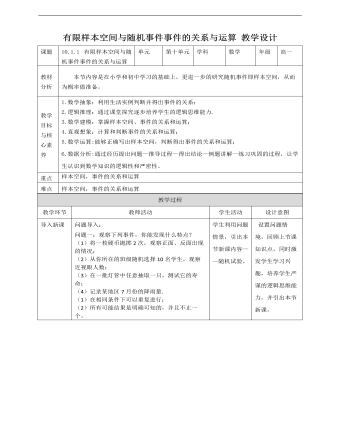
人教A版高中数学必修二有限样本空间与随机事件事件的关系和运算教学设计
新知讲授(一)——随机试验 我们把对随机现象的实现和对它的观察称为随机试验,简称试验,常用字母E表示。我们通常研究以下特点的随机试验:(1)试验可以在相同条件下重复进行;(2)试验的所有可能结果是明确可知的,并且不止一个;(3)每次试验总是恰好出现这些可能结果中的一个,但事先不确定出现哪个结果。新知讲授(二)——样本空间思考一:体育彩票摇奖时,将10个质地和大小完全相同、分别标号0,1,2,...,9的球放入摇奖器中,经过充分搅拌后摇出一个球,观察这个球的号码。这个随机试验共有多少个可能结果?如何表示这些结果?根据球的号码,共有10种可能结果。如果用m表示“摇出的球的号码为m”这一结果,那么所有可能结果可用集合表示{0,1,2,3,4,5,6,7,8,9}.我们把随机试验E的每个可能的基本结果称为样本点,全体样本点的集合称为试验E的样本空间。

小学数学人教版一年级上册《6、7加减法的应用》说课稿
说课内容:我说课的内容是人教版小学数学一年级上册第五单元、第三课时、6、7的加减法应用。我将从教材分析,教学目标分析,教学重难点及突破方法,教学流程设计,4个方面来进行说课。一、说教材:1、内容:本节课是在学生学习6、7加减法的基础上展开教学的,教材第一次出现用情景图呈现数学问题的形式,呈现了一个简单求和求差的数学问题,使学生明确、知道两个相关的信息和一个相关的问题,就构成了一个简单的数学问题。2、地位:从整个知识网络来看,它也标志着数学应用题数学的开始,是向后面的文字应用题过度的桥梁。二、说教学目标通过对教材的分析,确立了如下教学目标:1.通过学习使学生认识理解大括号和问号的意义,能借助图画正确分析题意。2.会用6和7的加减法解决生活中简单问题,使学生切实感受到用学过的数学知识去解决简单的实际问题的过程。3.初步感受数学与日常生活的密切联系,体验学数学、用数学的乐趣。
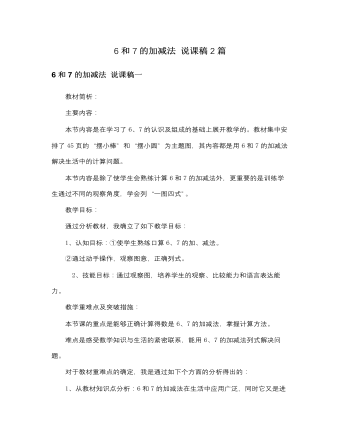
人教版新课标小学数学一年级上册6和7的加减法 说课稿2篇
教学重难点及突破措施:本节课的重点是能够正确计算得数是6、7的加减法,掌握计算方法。难点是感受数学知识与生活的紧密联系,能用6、7的加减法列式解决问题。对于教材重难点的确定,我是通过如下个方面的分析得出的:1、从教材知识点分析:6和7的加减法在生活中应用广泛,同时它又是进一步学习8和9以及10的加减法的最直接的基础。2、从学生心理特点和认知规律来分析:学生的思维能力和语言表达能力不是很强,通过观察的不同角度,能够列出不同的算式。一、复习6、7的组成及分解在上课之前,我先让学生背诵6 、7的组成及分解。这个内容在上《6和7的认识》这一课时时就已经让学生学习。在上新课前让学生背诵,一是让学生复习巩固以前的知识,二是为接下来计算6、7的加减法时做好铺垫。
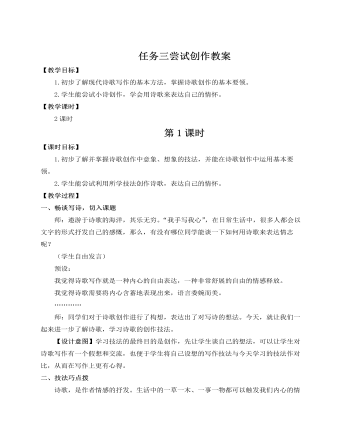
人教部编版语文九年级上册任务三尝试创作(2)教案
我认为这首诗,一共三节,每节句数、字数相当,结构工整,符合建筑美的特点,同时也使诗歌具有了节奏感;另外这首诗音韵和谐,朗朗上口。我认为这首诗相同句式回环往复,给人留下深刻印象。我认为此诗语言犹如清水出芙蓉,清丽淡雅,营造了唯美纯净的世界。…………师:节奏把握这一技巧相对比较简单,大家的创作和点评都很有水准,很好。希望大家在以后课余的诗歌创作中能兼顾到我们现在所谈的技巧。【设计意图】讲诗歌的创作技巧,既要讲出最关键的技巧,也要结合实例,让讲解深入浅出,让学生在理解的同时加以训练,使学生能够加深对知识点的理解。三、课内演练,巩固技法 学习本节课的技法之后,请大家写一首诗或一个诗歌片段,要求运用本节课所讲的诗歌写作技巧。(学生思考创作并展示)
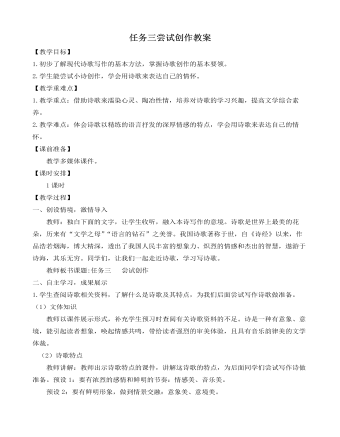
人教部编版语文九年级上册任务三尝试创作(1)教案
例如《你是山间的清泉》《你是天空的雄鹰》《你是三春晖》《你是燃烧的红烛》等。先想好歌颂的对象,再展开联想、想象,结合事物的特点,融入自己的情感。如要写“母亲”,想想由母亲的特质可以联想到什么具体形象,如从母亲的勤劳想到老黄牛,从母亲对孩子无私的爱和付出联想到阳光、雨露、蜡烛等。 范文引路:五、课后巩固,布置作业(福建漳州)题目:守护 (将题目补充完整,然后作文)要求:(1)文体不限,字数不少于600字(诗歌不少于30行)。(2)不得出现真实人名、校名。(3)字迹工整,卷面整洁。 写作点拨:预设:本题是半命题作文题,题目“守护”是一个动词后面可以跟宾主,如“快乐”“向往”“妈妈”“歌声”等,或抽象或具体,都可以,还可以拟题“守护者”等。“守护”分为几个层面:谁守护?守护什么?怎样守护?守护结果如何?如此等等。可以抓住其中一个层面,写叙事诗、抒情诗、论辩色彩浓郁的诗等。从题目要求看,诗歌不少于30行,这么长的诗歌适合分为几个,通过几个片段、镜头、故事、感想等来表现主题。
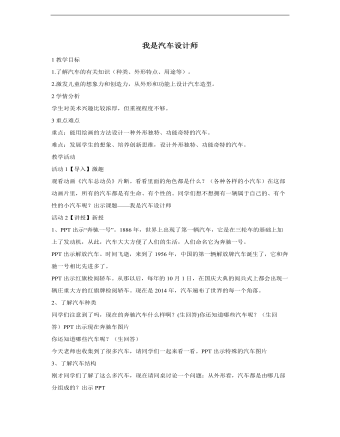
小学美术人教版四年级上册《第10课我是汽车设计师》教学设计说课稿
活动1【导入】激趣观看动画《汽车总动员》片断。看看里面的角色都是什么?(各种各样的小汽车)在这部动画片里,所有的汽车都是有生命、有个性的。同学们想不想拥有一辆属于自己的、有个性的小汽车呢?出示课题——我是汽车设计师活动2【讲授】新授1、PPT出示“奔驰一号”。1886年,世界上出现了第一辆汽车,它是在三轮车的基础上加上了发动机,从此,汽车大大方便了人们的生活,人们命名它为奔驰一号。PPT出示解放汽车。时间飞逝,来到了1956年,中国的第一辆解放牌汽车诞生了,它和奔驰一号相比先进多了。
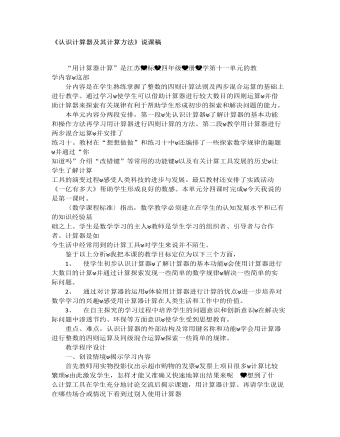
小学数学人教版四年级上册《认识计算器及其计算方法》说课稿
“用计算器计算”是江苏国标版四年级上册数学第十一单元的教学内容这部分内容是在学生熟练掌握了整数的四则计算法则及两步混合运算的基础上进行教学。通过学习使学生可以借助计算器进行较大数目的四则运算并借助计算器来探索有关规律有利于帮助学生形成初步的探索和解决问题的能力。 本单元内容分两段安排,第一段先认识计算器了解计算器的基本功能和操作方法再学习用计算器进行四则计算的方法。第二段教学用计算器进行两步混合运算并安排了练习十。教材在“想想做做”和练习十中还编排了一些探索数学规律的趣题并通过“你知道吗”介绍“改错键”等常用的功能键以及有关计算工具发展的历史让学生了解计算工具的演变过程感受人类科技的进步与发展。最后教材还安排了实践活动《一亿有多大》帮助学生形成良好的数感。本单元分四课时完成今天我说的是第一课时。
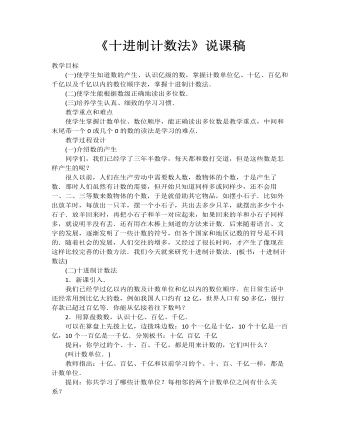
小学数学人教版四年级上册《十进制计数法》说课稿
(二)十进制计数法1.新课引入.我们已经学过亿以内的数及计数单位和亿以内的数位顺序.在日常生活中还经常用到比亿大的数,例如我国人口约有12亿,世界人口有50多亿,银行存款已超过百亿等.你能从亿接着往下数吗?2.用算盘数数,认识十亿、百亿、千亿.可以在算盘上先拨上亿,边拨珠边数:10个一亿是十亿,10个十亿是一百亿,10个一百亿是一千亿.分别板书:十亿 百亿 千亿提问:你学过的个、十、百、千亿,都是用来计数的,它们叫什么?(叫计数单位.)教师指出:十亿、百亿、千亿和以前学习的个、十、百、千亿一样,都是计数单位.
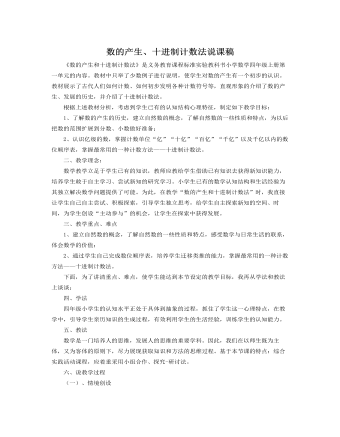
人教版新课标小学数学四年级上册数的产生、十进制计数法说课稿
2、十进制计数法(1)、师提问:“同学们,我们在前几节课已经学习了到万级为止的数,但是,还有比亿更大的数存在着,(出示数位顺序表):引导学生利用已有的知识进行类推,将已学过的亿以内数位顺序表扩展到“千亿”。教师在计数器上现场贴上亿级的数位。(教师向学生说明:还有比千亿更大的数,由于不常用,暂时不学,因此在数为顺序表后面用“…”,表示后面还有其他数位。)(2)、教师提问:“那么,我们已经学习了哪些计数单位呢?”(3)、小组讨论:“每相邻的两个计数单位之间的进率是多少?”请同学们自己得出结论:每相邻的两个计数单位之间的进率都是十。最后,教师给出“十进制计数法”的名称,在黑板上板书。(三)、课堂总结1、教师:“同学们,今天我们一起学习了?”教师请同学们接下去说完整:“自然数和十进制计数法。”
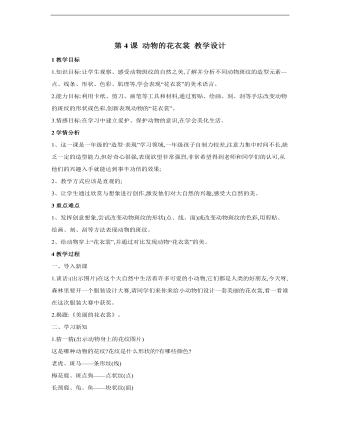
小学美术桂美版一年级上册《第4课动物的花衣裳》教学设计说课稿
2学情分析 1、这一课是一年级的“造型·表现”学习领域,一年级孩子自制力较差,注意力集中时间不长,缺乏一定的造型能力,但好奇心很强,表现欲望非常强烈,非常希望得到老师和同学们的认可,从他们的兴趣入手就能达到事半功倍的效果;2、教学方式应该是直观的;3、让学生通过欣赏与想象进行创作,激发他们对大自然的兴趣,感受大自然的美。
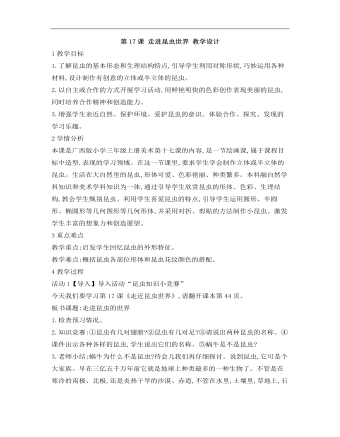
小学美术桂美版三年级上册《第17课走进昆虫世界》教学设计说课稿
2学情分析 本课是广西版小学三年级上册美术第十七课的内容,是一节绘画课,属于课程目标中造型.表现的学习领域。在这一节课里,要求学生学会制作立体或半立体的昆虫。生活在大自然里的昆虫,形体可爱、色彩艳丽、种类繁多。本科融自然学科知识和美术学科知识为一体,通过引导学生欣赏昆虫的形体、色彩、生理结构,教会学生甄别昆虫。利用学生喜爱昆虫的特点,引导学生运用圆形、半圆形、椭圆形等几何图形等几何形体,并采用对折、剪贴的方法制作小昆虫。激发学生丰富的想象力和创造愿望。
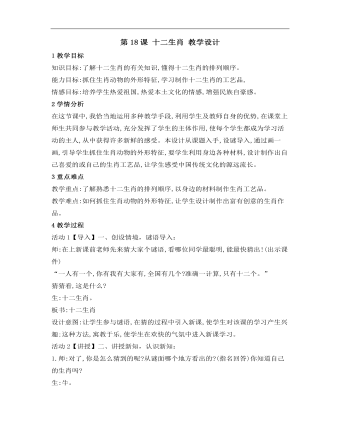
小学美术桂美版三年级上册《第18课十二生肖2》教学设计说课稿
2学情分析在这节课中,我恰当地运用多种教学手段,利用学生及教师自身的优势,在课堂上师生共同参与教学活动,充分发挥了学生的主体作用,使每个学生都成为学习活动的主人,从中获得许多新鲜的感受。本设计从课题入手,设谜导入,通过画一画,引导学生抓住生肖动物的外形特征,要学生利用身边各种材料,设计制作出自己喜爱的或自己的生肖工艺品,让学生感受中国传统文化的源远流长。
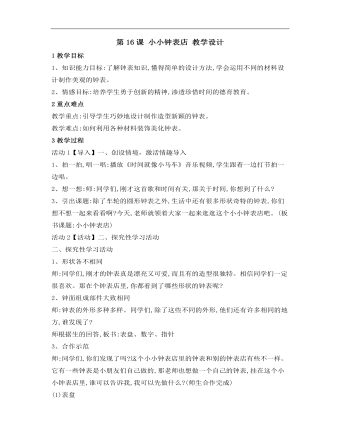
小学美术桂美版三年级上册《第16课小小钟表店1》教学设计说课稿
3教学过程活动1【导入】一、创设情境,激活情趣导入 1、拍一拍,唱一唱:播放《时间就像小马车》音乐视频,学生跟着一边打节拍一边唱。2、想一想:师:同学们,刚才这首歌和时间有关,那关于时间,你想到了什么?3、引出课题:除了车轮的圆形钟表之外,生活中还有很多形状奇特的钟表,你们想不想一起来看看啊?今天,老师就领着大家一起来逛逛这个小小钟表店吧。(板书课题:小小钟表店)
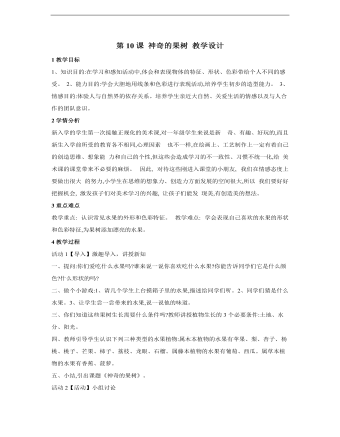
小学美术桂美版一年级上册《第10课神奇的果树》教学设计说课稿
2学情分析 新入学的学生第一次接触正规化的美术课,对一年级学生来说是新 奇、有趣、好玩的,而且新生入学前所受的教育各不相同,心理因素 也不一样,在绘画上、工艺制作上一定有着自己的创造思维、想象能 力和自己的个性,但这些会造成学习的不一致性、习惯不统一化,给 美术课的课堂带来不必要的麻烦。因此, 对待这些刚进入课堂的小朋友, 我们在情感态度上要做出很大 的努力,小学生在思维的想象力、创造力方面发展的空间很大,所以 我们要好好把握机会, 激发孩子们对美术学习的兴趣,让孩子们能发 现美,有创造美的想法。
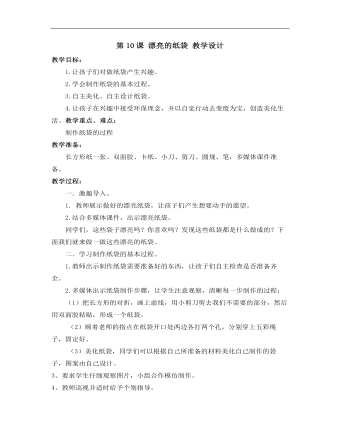
小学美术桂美版三年级上册《第10课漂亮的纸袋》教学设计说课稿
一.激趣导入。 1. 教师展示做好的漂亮纸袋,让孩子们产生想要动手的愿望。 2.结合多媒体课件,出示漂亮纸袋。 同学们,这些袋子漂亮吗?你喜欢吗?发现这些纸袋都是什么做成的?下面我们就来做一做这些漂亮的纸袋。 二.学习制作纸袋的基本过程。 1.教师出示制作纸袋需要准备好的东西,让孩子们自主检查是否准备齐全。 2.多媒体出示纸袋制作步骤,让学生注意观察,清晰每一步制作的过程: (1)把长方形的对折,画上虚线,用小剪刀剪去我们不需要的部分,然后用双面胶粘贴,形成一个纸袋。
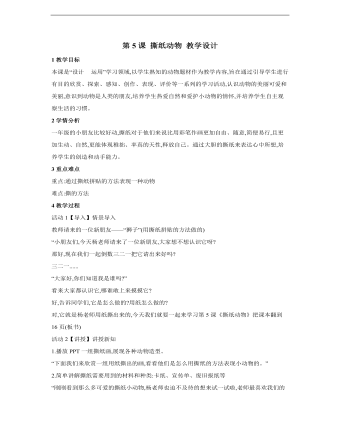
小学美术桂美版一年级上册《第5课撕纸动物》教学设计说课稿
2学情分析 一年级的小朋友比较好动,撕纸对于他们来说比用彩笔作画更加自由、随意,简便易行,且更加生动、自然,更能体现稚拙、率真的天性,释放自己。通过大胆的撕纸来表达心中所想,培养学生的创造和动手能力。3重点难点 重点:通过撕纸拼贴的方法表现一种动物难点:撕的方法
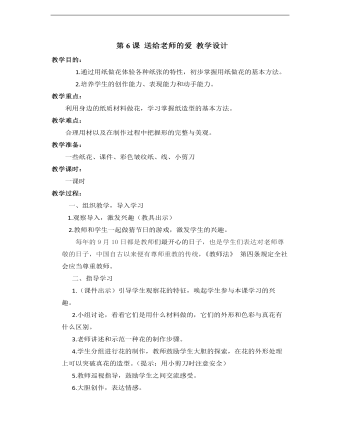
小学美术桂美版一年级上册《第6课送给老师的爱》教学设计说课稿
教学过程:一、组织教学,导入学习1.观察导入,激发兴趣(教具出示)2.教师和学生一起做猜节日的游戏,激发学生的兴趣。 每年的9月10日都是教师们最开心的日子,也是学生们表达对老师尊敬的日子,中国自古以来便有尊师重教的传统,《教师法》 第四条规定全社会应当尊重教师。
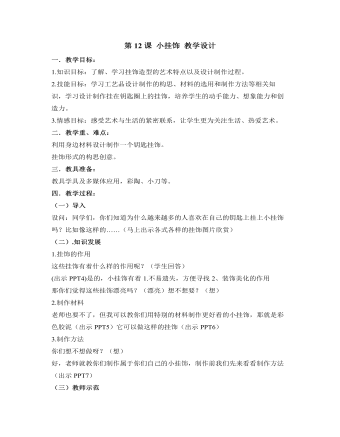
小学美术桂美版三年级上册《第12课小挂饰3》教学设计说课稿
二.教学重、难点:利用身边材料设计制作一个钥匙挂饰。挂饰形式的构思创意。三.教具准备:教具学具及多媒体应用,彩陶、小刀等。四.教学过程:(一)导入设问:同学们,你们知道为什么越来越多的人喜欢在自己的钥匙上挂上小挂饰吗?比如像这样的……(马上出示各式各样的挂饰图片欣赏)



